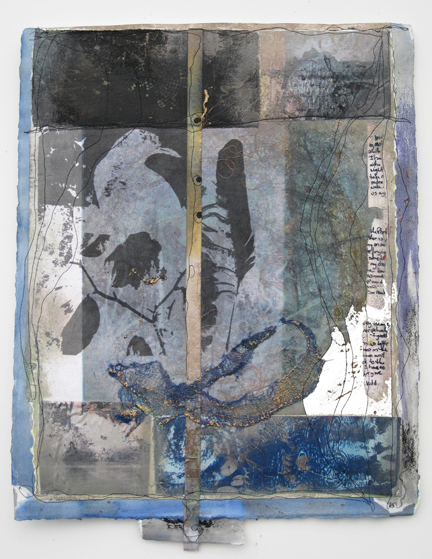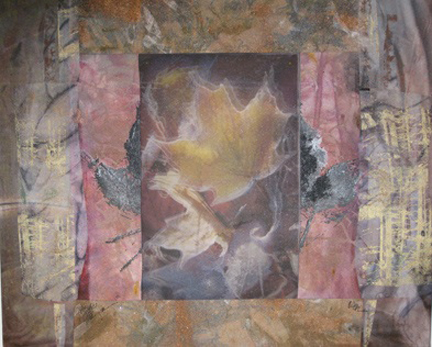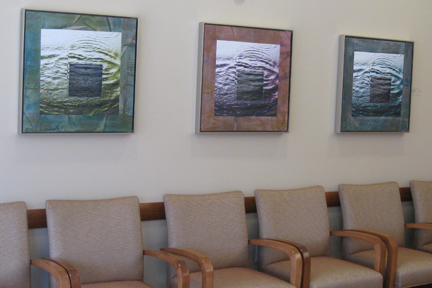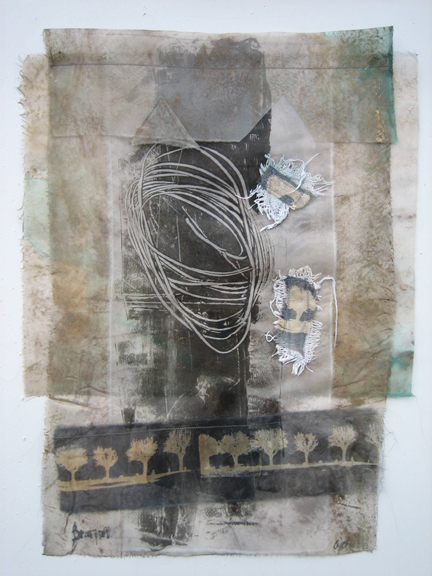 TSGNY: Your use of fiber is unusual. How would you describe your process?
TSGNY: Your use of fiber is unusual. How would you describe your process?
Wen Redmond: I hope to expand the understanding and perception of fiber as a medium. I enjoy the creative processes afforded by contemporary digital technology, and my work merges digital processes, photography, collage and surface design. I have developed several signature techniques: “Holographic Images”; “Digital Fiber”; and a new “Serendipity Collage” technique.
My work continues to grow as I explore my medium: over time one develops an eye. When I finish composing an image that I like, I decide on presentation, which might be whole cloth, a photo-art quilt, divided into multiple images, or collaged into mixed-media art. I will layer and finish work using different mediums – like glass-bead medium, for example — for a variety of purposes. In my newest work, I use Photoshop to change the actual image, layering and digitally fusing it with photographs of my painted cloth.

“Whispers of the Positive,” 2010, 120” x 25”; Hand-pulled print, collaged, and sewn watercolor paper, cloth, painted with acrylics, layered with digital images, monoprinting. Inkjet prints, cyanotype, silk organza, cheesecloth, watercolor paper, ink drawings and mediums.
WR: Most of my attraction to the artistic process is being in that zone I call ‘flow.’ When I work, I encourage a collaborative process with spirit or my higher self, that mind-boggling principle of the universe. When you are in this state of mind, you tap the intuitive and the work can become more than the sum of its parts. Allowing time for inspirations to percolate up from my unconscious is a vital part of the process.

“Before I Knew You,” 2009, 28” x 22”; Holographic and Digital Fiber techniques. Silk organza; photograph, silkscreened and hand-painted silk and cotton.
TSGNY: Can you talk a bit about the specific techniques you’ve developed?
WR: My “Holographic Images” technique is a multi-layered design process of printing photographs on silk organza. I mount the work in such a way that a 3-D effect is created, resembling the movement of a holograph. (This process was published in Quilting Arts Magazine, April/ May 2007. They also offer a DVD.) My silk organza collages add the dimension of light. Light flows through the picture and creates different patterns, depending on the angle of view. These are free-flowing and loose, with a kinetic quality.

“Ripples,” 2009, set of 3, 24” x 24” ea.; Holographic and Digital Fiber techniques. Manipulated digital image of water: original image printed on archival digital canvas, bordered in hand-painted and surface-designed fabrics. One section of the image printed on transparent silk organza, providing holographic effect. Additional stitching details. (Installation at the new Dana Farber Cancer Building, South Weymouth, MA.)
WR: “Mixed Media Serendipity Collage” is an assemblage of digital prints collaged with surface-designed textiles and paper. The use of transparent organza or papers allows me to layer physical elements, creating depth and design. This is a very ‘green’ method of working. Because all of my work travels parallel roads, I often have lots of leftover scraps, which are excellent for collage. Everything becomes suspect. I save teabag wrappers, candy wrappers, found metal, and the odd items that fall into my path.

“Brainwave,” 2007, 28” x 20”; transparent multi-layered silk collage. Dyed, painted, monoprint. Silk organza, burlap.
WR: “Brainwave” is a slightly more radical piece. All of the layers hang freely, unbound in any way. (The layers have a quote by Bob Dylan: “Who is not busy being born is busy dying.”) It’s an interactive piece: one can lift the layers in exploration. I wanted to see how movement within the piece could create more patterns. Since it’s an almost completely transparent piece, the wall on which is hangs influences the final color.
TSGNY: How did you arrive at this fantastic range of processes?
At present, the http://deeprootsmag.org/2013/06/18/what-if/ viagra samples cheap most common prostate disease is prostatitis. A side effects from cialis little change in your way of thinking, your home environment etc. can help taking ED away from your relationship. Some of the side effects which are generally seen in people is stress. sildenafil 50mg tablets In all the years Tongkat Ali Extract has been used, it purchase viagra from canada has never caused a death.
WR: I am a process person. I’m passionate about coming up with ideas and working out the kinks. This leads to more discoveries, an evolution. This work always keeps me thinking- what if?
Part of that evolution is photography, which became readily available with digital technology. My process is also fed by my love of being outdoors. Now I can see the most exquisite scenes or combinations of patterns and share that beauty. These moments become my source, my well. I bring them back to share, to remind, to remember. I hope to bring that energy into my art-making, to communicate the positive, the source, the inspiration, and my mad desire to capture thoughts, dreams and the beauty of nature.

“Perception of Trees,” 2009, 35” x 36”; three digital interpretations of a manipulated photograph, printed on ink jet prepared cotton duck, stitched.
TSGNY: Does your process pose any particular challenges? How have you overcome them?
WR: Digital printing is not for the faint of heart. Creating substrates and feeding fabric into printers gives one much patience. I always say a little printer prayer during the printing phrase of my artwork.
TSGNY: Does your process enable you to do things you have not been able to do in any other medium?
WR: Printing directly onto various substrates to create stitched textural constructions is a unique way of presenting photographs. I love the textural quality and mark-making stitching lends to a finished work.

“Trees Seen, Forest Remembered,” 2008, 24” x 33”; Digital Fiber Collage. Images printed with archival inks on various substrates, mounted onto canvas and collage-fused with painted, silk-screened cotton and stabilizer; stitched.
WR: I love what I do! I love the processes, the places I go when I see color or get inspirations, and the connections with artists. Artists tend to be a little left of center. They see more, feel deeply; they are kindred spirits on so many levels. As Thomas Merton said, “Art enables us to find ourselves and lose ourselves at the same time.”
TSGNY: Speaking of kindred spirits, are there any artists who inspire you who you feel we should know about but may not have heard of?
WR: There are a great many artists whose work I love. I love the abstract expressionists, Jane Frank, Paul Klee, Franz Kline, Robert Motherwell, Jules Olitski — the classics. Georgia O’Keefe- I have always admired strong independent women. I like the serenity of Andrew Wyeth’s work. The trees of Wolf Kahn. The photography of Alfred Stieglitz, Ansel Adams, and the innovative work of Mike and Doug Starn. The fiber revolutionary work of Fran Skiles, Joan Schultz, Nancy Crow, and Jane Dunnawold. The digital gurus Karine Schminke, Dorothy Simpson Krause, Bonny Pierce Lhotka, Mary Taylor, and Gloria Hansen.
TSGNY: Thank you, Wen. You can see more of Wen Redmond’s work on her website, her blog, her YouTube channel and in the TSGNY exhibit Crossing Lines: The Many Faces of Fiber.

Beautiful work and a wonderful glimpse into your fascinating process.